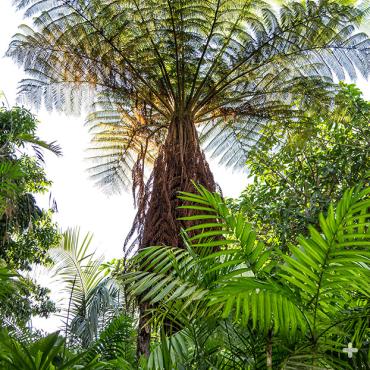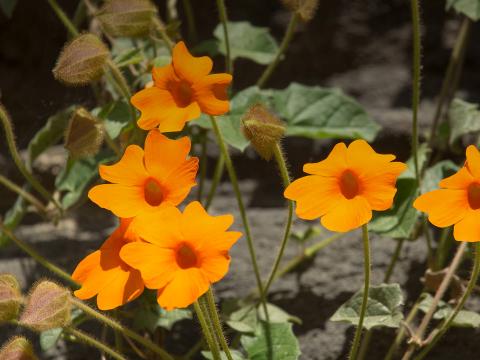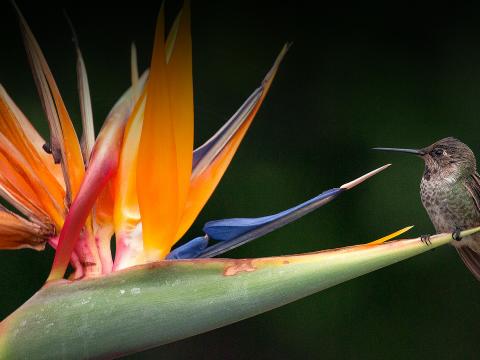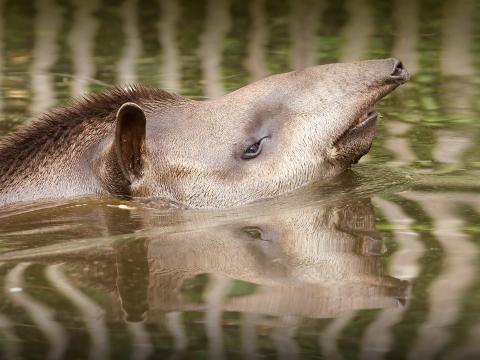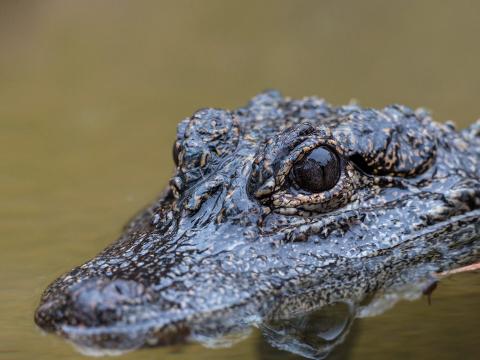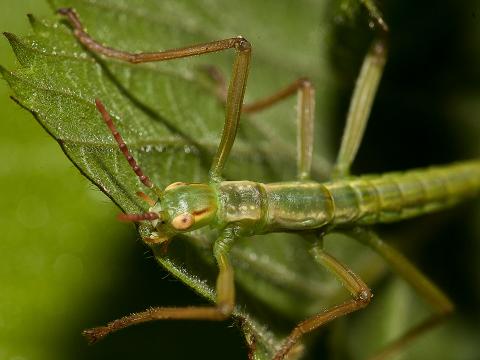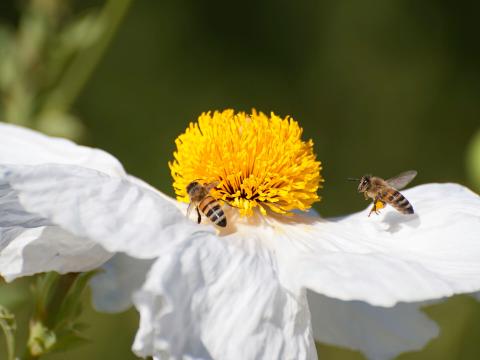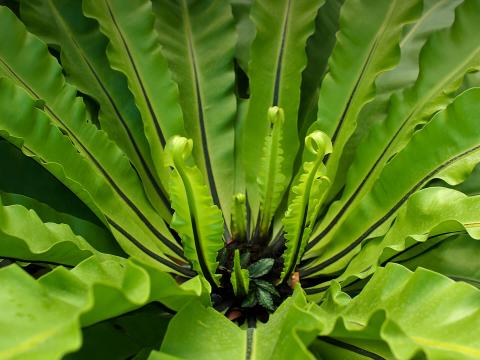Tree Fern
- Division: Pteridophyta
- Class: Pteridopsida
- Order: Cyatheales
- Family: Cyatheaceae, Dicksoniaceae
- Genus: Cyathea, Dicksonia
- Species: about 500 species of Cyathea; about 25 species of Dicksonia
Overview
If you walked through a forest filled with towering tree ferns, you’d experience a glimpse into the world of the dinosaurs. Tree ferns have been found in the fossil record stretching back to the Jurassic and Triassic Periods—they’ve been around for more than 200 million years! Today, the two larger groups of tree ferns are those in the Cyathea genus, generally referred to as the scaly or rough tree ferns, and the Dicksonia genus, referred to as the soft tree ferns. Although they are no longer food for towering reptilian giants, they remain an important part of their habitats and are popular with gardeners, as well.
Characteristics
Trunk
A tree fern trunk is really a solid, upright accumulation of rhizomes, tightly packed together to form a rigid support for the fronds and embedded in a dense mantle of modified roots. This structure serves a similar purpose to the trunk of a tree: the rhizomes hold up the crown and transport water and nutrients from the roots to the fronds. These trunks can reach 65 feet (19.8 meters) or more in some varieties.
One of the differences between Cyathea and Dicksonia is that Cyathea tend to have hard, coarse trunks, often patterned with the circular marks where the fronds have been shed. Dicksonia tend to have a more pliable, fibrous trunk covered in hairs, and its frond bases remain on the trunk instead of being dropped. The hairs on Dicksonia will regenerate new fronds if the trunk is cut off or damaged; Cyathea does not have that capability.
Fronds
At the top of the trunk there is a growing tip that produces the cluster of often highly divided fronds. The fronds start from curled structures at the top of the fern call crosiers, which are really the very tip of rhizomes that have grown up from the ground within the trunk.
Tree fern fronds are often very large, some of the largest leaf structures in the Plant Kingdom: they can reach 9 to 13 feet (2.7 to 4 meters) in length in some. The fronds are covered in scales and hairs; Cyathea fronds tend to be more scaly, and there are even spines at the base of the fronds in some types.
Spores
The undersides of the mature fronds are covered with dusty brown sori aligned in rows. The sori have a membranous protective covering called an indusium (found on other types of ferns as well), which can take various forms, including umbrella-shaped, kidney-shaped, and globe-shaped. The sori occur away from the margins of the frond pinnules and are elongated or rounded, and they protect the developing masses of dusty brown spores.
Certainly Cyathea or Definitely Dicksonia?
Cyathea is the largest group of tree ferns, with more than 500 species, and it also includes the world’s tallest tree ferns. These tree ferns tend to be faster growing than other types and are usually found in warm, tropical climates. Here the growing conditions are ideal, with stable temperatures and high humidity and rainfall, and encourage rapid growth to reach higher toward the sunlight.
The durable Dicksonia group only has about 25 species, but they include some of the most important and widely cultivated tree ferns in Europe and North America. These tree ferns are thought to be older than Cyathea, and because many grow in cooler climates, they tend to be slower growing. Some can reach heights of up to 50 feet (15.2 meters) over time, however, and live for hundreds of years.
Conservation
Several tree ferns have become rare as a result of over-collection by humans. The mantle on a tree fern trunk has been a commercial source of “orchid bark,” a fibrous substrate for cultivating orchids and other epiphytic plants. Tree fern trunks have been carved into tiki statues and other craft items typically sold to tourists in tropical resorts. When the trunks are sliced, the cross sections produce a beautiful pattern of light and dark from the vascular system of the stem and the leaf traces, and these have been used for various handcrafted items, including plates. A number of varieties have also been collected for cultivation in greenhouses and conservatories.
All tree ferns are considered threatened since most are found in the rapidly diminishing rainforests and cloud forests of the world. Governments have responded to the conservation threats by listing most tree ferns under the Convention on International Trade in Endangered Species of Wild Fauna and Flora (CITES), which prohibits international commerce involving these plants without a special permit. It is illegal to ship tree ferns or tree fern products internationally. However, this does not protect tree ferns within a country from destruction, and they still need protection in their native habitats.
Our Collection
Look for these three tree ferns in the Zoo’s Fern Canyon.
Scaly tree fern Cyathea cooperi
Originally native to eastern Australia, this is one of the most common tree ferns found in subtropical regions, since it is fast growing and quick to establish. It gets the name scaly tree fern from the pattern of marks on its trunk left by fallen fronds, which somewhat resemble the scales of a reptile. It’s also sometimes called the lacy tree fern because of its delicate frond structure. This fern can grow to 40 feet (12.2 meters) in height, and its elegant, arching fronds can be over 10 feet (3.1 meters) in length.
Black tree fern Cyathea medullaris
This tree fern is considered the king of the New Zealand tree ferns, and its Maori names include mamaku, katata, korau, or pitau. It also grows on several Pacific islands, including Pitcairn, Marquesas, Samoa, Tahiti, and Fiji. It is a striking fern with a slender, black trunk and elegant, long fronds that arch upwards from the crown. The upper surfaces of the fronds are a shiny, dark green and the undersides are a lighter jade green.
Tasmanian tree fern Dicksonia antarctica
This tree fern is considered one of the most cold tolerant, surviving temperatures as low as 14 degrees Fahrenheit (-10 degrees Celsius). Other common names for this attractive, dark green fern include hardy tree fern, soft tree fern, and Australian tree fern. It is found from southeastern Queensland, through the New South Wales and Victoria coastal areas, and in Tasmania. This tree fern prefers to live in moist areas like creek beds, in gullies, and occasionally at high altitudes in cloud forests.
Tasmanian tree ferns were one of the types that became popular during the fern craze of the 19th century. The first to arrive in the United Kingdom came aboard ships returning from Australia, where they served as ballast or weights in the holds, to prevent cargo moving about in heavy seas. At the docks, the trunks were discarded when the ships were unloaded. People began to notice that these trunks were growing new fronds and that, in time, the ends of the trunks were turning upwards and starting to grow toward the light—showing they could be at home in Britain.



